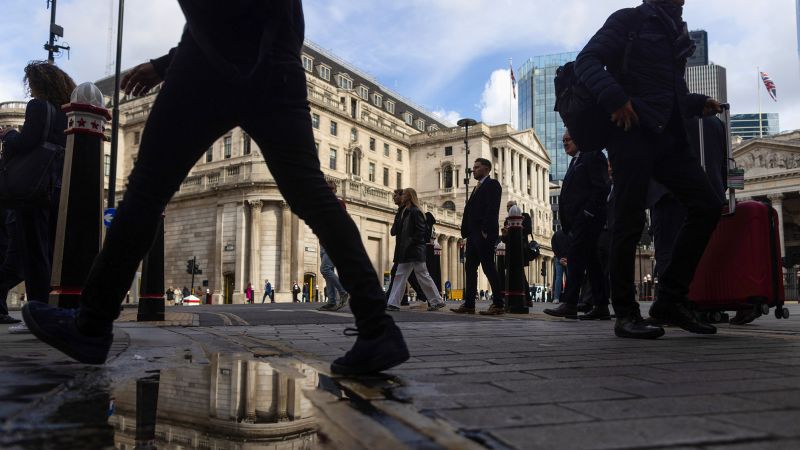5 signs the world is headed for a recession



Around the world, markets are flashing warning signs that the global economy is teetering on a cliff’s edge.
The question of a recession is no longer if, but when.
Over the past week, the pulse of those flashing red lights quickened as markets grappled with the reality — once speculative, now certain — that the Federal Reserve will press on with its most aggressive monetary tightening campaign in decades to wring inflation from the US economy. Even if that means triggering a recession. And even if it comes at the expense of consumers and businesses far beyond US borders.
There’s now a 98% chance of a global recession, according to research firm Ned Davis, which brings some sobering historical credibility to the table. The firm’s recession probability reading has only been this high twice before — in 2008 and 2020.
When economists warn of a downturn, they’re typically basing their assessment on a variety of indicators.
Let’s unpack five key trends:
The mighty US dollar
The US dollar plays an outsized role in the global economy and international finance. And right now, it is stronger than it’s been in two decades.
The simplest explanation comes back to the Fed.
When the US central bank raises interest rates, as it has been doing since March, it makes the dollar more appealing to investors around the world.
In any economic climate, the dollar is seen as a safe place to park your money. In a tumultuous climate — a global pandemic, say, or a war in Eastern Europe — investors have even more incentive to purchase dollars, usually in the form of US government bonds.
While a strong dollar is a nice perk for Americans traveling abroad, it creates headaches for just about everyone else.
The value of the UK pound, the euro, China’s yuan and Japan’s yen, among many others, has tumbled. That makes it more expensive for those nations to import essential items like food and fuel.
In response, central banks that are already fighting pandemic-induced inflation wind up raising rates higher and faster to shore up the value of their own currencies.
The dollar’s strength also creates destabilizing effects for Wall Street, as many of the S&P 500 companies do business around the world. By one estimate from Morgan Stanley, each 1% rise in the dollar index has a negative 0.5% impact on S&P 500 earnings.
America’s economic engine stalls
The No. 1 driver of the world’s largest economy is shopping. And America’s shoppers are tired.
After more than a year of rising prices on just about everything, with wages not keeping up, consumers have pulled back.
“The hardship caused by inflation means that consumers are dipping into their savings,” EY Parthenon Chief Economist Gregory Daco said in a note Friday. The personal saving rate in August remained unchanged at only 3.5%, Daco said — near its lowest rate since 2008, and well below its pre-Covid level of around 9%.
Once again, the reason behind the pullback has a lot to do with the Fed.
Interest rates have risen at a historic pace, pushing mortgage rates to their highest level in more than a decade and making it harder for businesses to grow. Eventually, the Fed’s rate hikes should broadly bring costs down. But in the meantime, consumers are getting a one-two punch of high borrowing rates and high prices, especially when it comes to necessities like food and housing.
Americans opened their wallets during the 2020 lockdowns, which powered the economy out of its brief-but-severe pandemic recession. Since then, government aid has evaporated and inflation has taken root, pushing prices up at their fastest rate in 40 years and sapping consumers’ spending power.
Corporate America tightens its belt
Business has been booming across industries for the bulk of the pandemic era, even with historically high inflation eating into profits. That is thanks (once again) to the tenacity of American shoppers, as businesses were largely able to pass on their higher costs to consumers to cushion profit margins.
But the earnings bonanza may not last.
In mid-September, one company whose fortunes serve as a kind of economic bellwether gave investors a shock.
FedEx, which operates in more than 200 countries, unexpectedly revised its outlook, warning that demand was softening, and earnings were likely to plunge more than 40%.
In an interview, its CEO was asked whether he believes the slowdown was a sign of a looming global recession.
“I think so,” he responded. “These numbers, they don’t portend very well.”
FedEx isn’t alone. On Tuesday, Apple’s stock fell after Bloomberg reported the company was scrapping plans to increase iPhone 14 production after demand came in below expectations.
And just ahead of the holiday season, when employers would normally ramp up hiring, the mood is now more cautious.
“We’ve not seen the normal September uptick in companies posting for temporary help,” said Julia Pollak, chief economist at ZipRecruiter. “Companies are hanging back and waiting to see what conditions hold.”
Welcome to bear territory
Wall Street has been hit with whiplash, and stocks are now on track for their worst year since 2008 — in case anyone needs yet another scary historical comparison.
But last year was a very different story. Equity markets thrived in 2021, with the S&P 500 soaring 27%, thanks to a torrent of cash pumped in by the Federal Reserve, which unleashed a double-barreled monetary-easing policy in the spring of 2020 to keep financial markets from crumbling.
The party lasted until early 2022. But as inflation set in, the Fed began to take away the proverbial punch bowl, raising interest rates and unwinding its bond-buying mechanism that had propped up the market.
The hangover has been brutal. The S&P 500, the broadest measure of Wall Street — and the index responsible for the bulk of Americans’ 401(k)s — is down nearly 24% for the year. And it’s not alone. All three major US indexes are in bear markets — down at least 20% from their most recent highs.
In an unfortunate twist, bond markets, typically a safe haven for investors when stocks and other assets decline, are also in a tailspin.
Once again, blame the Fed.
Inflation, along with the steep rise in interest rates by the central bank, has pushed bond prices down, which causes bond yields (aka the return an investor gets for their loan to the government) to go up.
On Wednesday, the yield on the 10-year US Treasury briefly surpassed 4%, hitting its highest level in 14 years. That surge was followed by a steep drop in response to the Bank of England’s intervention in its own spiraling bond market — amounting to tectonic moves in a corner of the financial world that is designed to be steady, if not downright boring.
European bond yields are also spiking as central banks follow the Fed’s lead in raising rates to shore up their own currencies.
Bottom line: There are few safe places for investors to put their money right now, and that’s unlikely to change until global inflation gets under control and central banks loosen their grips.
War, soaring prices and radical policies collide
Nowhere is the collision of economic, financial, and political calamities more painfully visible than in the United Kingdom.
Like the rest of the world, the UK has struggled with surging prices that are largely attributable to the colossal shock of Covid-19, followed by the trade disruptions created by Russia’s invasion of Ukraine. As the West cut off imports of Russian natural gas, energy prices have soared and supplies have dwindled.
Those events were bad enough on their own.
But then, just over a week ago, the freshly installed government of Prime Minister Liz Truss announced a sweeping tax-cut plan that economists from both ends of the political spectrum have decried as unorthodox at best, diabolical at worst.
In short, the Truss administration said it would slash taxes for all Britons to encourage spending and investment and, in theory, soften the blow of a recession. But the tax cuts aren’t funded, which means the government must take on debt to finance them.
That decision set off a panic in financial markets and put Downing Street in a standoff with its independent central bank, the Bank of England. Investors around the world sold off UK bonds in droves, plunging the pound to its lowest level against the dollar in nearly 230 years. As in, since 1792, when Congress made the US dollar legal tender.
The BOE staged an emergency intervention to buy up UK bonds on Wednesday and restore order in financial markets. It stemmed the bleeding, for now. But the ripple effects of the Trussonomics turmoil is spreading far beyond the offices of bond traders.
Britons, who are already in a cost-of-living crisis, with inflation at 10% — the highest of any G7 economy — are now panicking over higher borrowing costs that could force millions of homeowners’ monthly mortgage payments to go up by hundreds or even thousands of pounds.
The upshot
While the consensus is that a global recession is likely sometime in 2023, it’s impossible to predict how severe it will be or how long it will last. Not every recession is as painful as the 2007-09 Great Recession, but every recession is, of course, painful.
Some economies, particularly the United States, with its strong labor market and resilient consumers, will be able to withstand the blow better than others.
“We are in uncharted waters in the months ahead,” wrote economists at the World Economic Forum in a report this week.
“The immediate outlook for the global economy and for much of the world’s population is dark,” they continued, adding that the challenges “will test the resilience of economies and societies and exact a punishing human toll.”
But there are some silver linings, they said. Crises force transformations that can ultimately improve standards of living and make economies stronger.
“Businesses have to change. This has been the story since the pandemic started,” said Rima Bhatia, an economic adviser for Gulf International Bank. “Businesses no longer can continue on the path that they were at. That’s the opportunity and that’s the silver lining.”
Source: CNN Technology


%20FolderDrive%20USB-C,%20Up%20Phone,%20Odyssey%20OLED%20G6,%20Ultrahuman%20Ring%20Air%20&%20Samsung%E2%80%99s%20115%E2%80%B3%20TV1.jpg)








